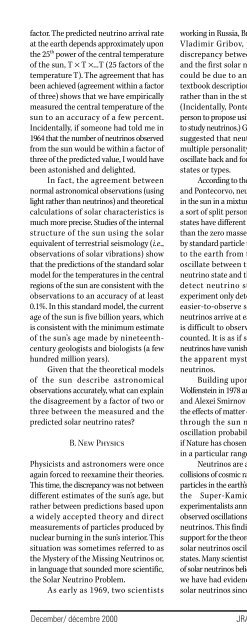I N S I D E T H I S I S S U E
insidethisissue - The Royal Astronomical Society of Canada
insidethisissue - The Royal Astronomical Society of Canada
- No tags were found...
You also want an ePaper? Increase the reach of your titles
YUMPU automatically turns print PDFs into web optimized ePapers that Google loves.
ABSTRACTS OF PAPERS PRESENTED AT THE 2000 CASCAANNUAL MEETING HELD IN VANCOUVER, MAY 25-28, 2000J.S. Plaskett Medal Lecture/Conférence de la médaille J.S. Plaskett3D Radiative Transfer to Compute the Inhomogeneous Reionization,Alexei Razoumov, University of California, San DiegoA numerical scheme for the solution of the three-dimensional, frequencyand time dependent radiative transfer equation with variable opticaldepth is developed for modelling the reionization of the Universe. Untilnow, the main difficulty in simulating the inhomogeneous reionizationhas been the treatment of cosmological radiative transfer. The proposedapproach is drastically different from previous studies, which eitherresorted to a very simplified, parametric treatment of radiative transferor relied on one-dimensional models. The algorithm presented hereis based on explicit multidimensional advection of wavefronts at thespeed of light, combined with the implicit solution of the local chemicalrate equations separately at each point. We have shown that this methodis an attractive choice for simulation of astrophysical ionization fronts,particularly when one is interested in covering a wide range of opticaldepths within a 3D clumpy medium. This scheme is then applied tothe calculation of time-dependent, multi-frequency radiative transferduring the epoch of first object formation in the Universe. In a seriesof models, the 2.5 Mpc (comoving) simulation volume is evolved betweenthe redshifts of z = 15 and 10 for different scenarios of star formationand quasar activity. The current numerical resolution is 128 3 (spatial)× 10 2 (angular) × 3 (frequency), and at each point in space we calculatevarious stages of hydrogen and helium ionization accounting for ninechemical species altogether. These models can be used to predict theobservational signatures of the earliest astrophysical objects in theUniverse. At present, the calculations are accurate enough to resolveprimordial objects to the scale typical of globular clusters, 1 × 10 6 solarmasses.Contributed Papers/Présentations oralesUnveiling Dwarf Galaxies in Low Redshift Galaxy Clusters, W. A. Barkhouseand H. K. C. Yee, University of Toronto, and O. López-Cruz, InstitutoNacional de Astrofísica Óptica y Electrónica, MexicoWe have recently completed a comprehensive photometric survey of27 Abell clusters (0.02 < z < 0.04) with the 8k mosaic camera on theKPNO 0.9-m telescope. The dwarf galaxy population has been characterizedby constructing luminosity functions, measuring spatial variations,dwarf-to-giant galaxy ratios, and colour distributions. Preliminaryresults for several galaxy clusters will be presented.The Magnetic Field Configuration in the Outer Region of the Galaxy, J.C.Brown and A.R. Taylor, University of CalgarySeveral studies have demonstrated that the Galaxy has a magneticfield with an ordered large-scale structure. We do not, however, knowhow that field is generated, how it is evolving, or what its overall structureis. It is generally believed that the magnetic field follows the basicpattern of the spiral arms of the Galaxy, yet the field’s strength anddirection between and within the arms is unknown. Different theoreticalmodels of the generation and evolution of the magnetic field predictdifferent directions. Studying the magnetic field and looking for“reversals,” where the field’s direction changes by 180 degrees, will helpidentify which model is correct. The focus of our research is to userotation measures from extragalactic point sources in the CanadianGalactic Plane Survey (CGPS), in conjunction with established datafrom pulsars to infer information about the Galaxy’s magnetic field.In particular, we hope to resolve the debate over how many (if any)reversals are present in the outer region of the Galaxy. In our paper, wewill discuss the status of our work to address this question and presenta comparison between measured rotation measures and those calculatedfrom different magnetic field models of the outer Galaxy.H ii Region NRAO 655 and its ISM Environment, T. Foster and D. Routledge,University of AlbertaNew radio and optical observations of Galactic surroundings near (l,b) = (94°, 2°) are presented, revealing new information about theinterstellar medium and objects in this locale. Of eleven Galactic objectsin this neighbourhood, for example, only two have published distanceestimates. In this paper, we present new CGPS radio continuumobservations of the H ii region NRAO 655 (G93.4 + 1.8) at 21 cm and74 cm, and optical and radio emission line observations at 656 nm and21 cm. The radio spectrum of this object confirms its emission asthermal in origin. From the CGPS H i data we find an atomic hydrogencavity associated with this object at v = –71.5 km s –1 . This H i cavitycorresponds in position and size to the brightest radio continuumemission from NRAO 655. The corresponding kinematic distance is8.8 kpc, and NRAO 655’s linear size is therefore 70 pc × 130 pc. Toconfirm the ( = 21 cm) H i velocity we present the first recombinationline detection of NRAO 655 H158 () line, v = –72 km s –1 , width 40 kms -1 , and the first observations of a molecular cloud interacting withNRAO 655 (at –72 km s –1 ). The first detection of NRAO 655 in (H)emission line is also presented, and astrophysical properties aredetermined from the nebula’s (H) emission line luminosity. We findgood correlation between optical and radio morphology and betweenIRAS 60 m infrared and radio morphology. We find anti-correlationbetween optical and infrared features, suggesting absorption of (H)light emitted from NRAO 655 by dust present in the nebula. A physicalmodel for NRAO 655 and its environment is proposed.Sub-millimetre Polarimetry of Star Forming Regions in Orion B, GeraldH. Moriarty-Schieven, National Research Council, Joint AstronomyCentre, Brenda Matthews, McMaster University, and Jason Fiege,Canadian Institute of Theoretical AstrophysicsPolarimetry of sub-millimetre dust emission allows one to trace thestructure of magnetic fields perpendicular to the line-of-sight. Wepresent polarimetric images, obtained with the SCUBA polarimeter246Journal of the Royal Astronomical Society of Canada, 94: 246—251, 2000 DecemberDecember / décembre 2000
















